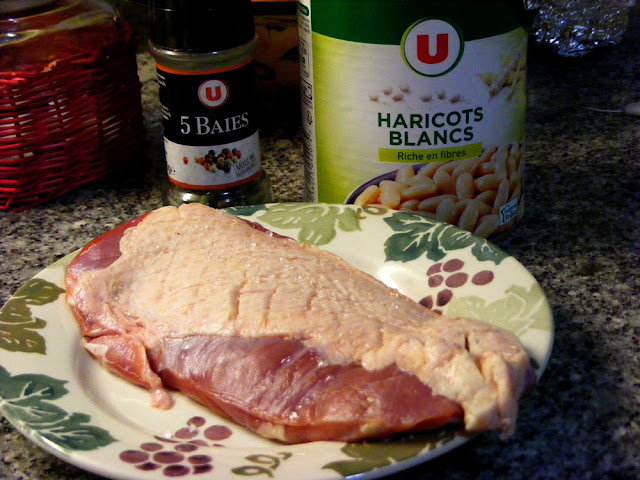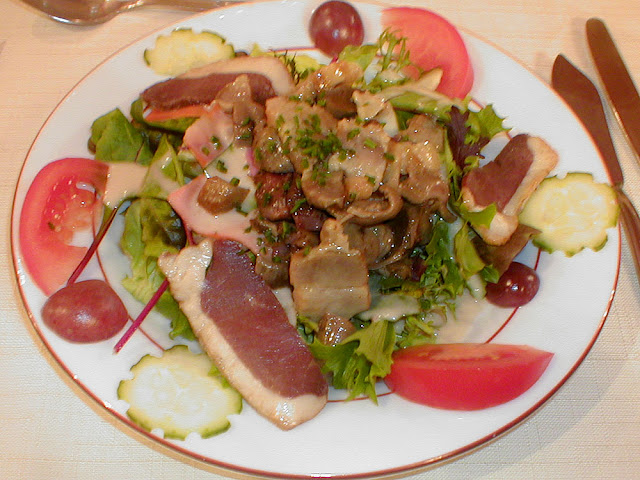Fat duck breasts (magret de canard) are a by-product of foie gras production and therefore widely available at quite reasonable prices. I can buy them directly from my local producer, or from the supermarket, year round. The supermarket has 3-packs of them on special a couple of times a year, so I can buy three magret for under €15 and freeze them. (No, I don't know why they are packaged in threes...). In this recipe the raw duck breast is 'cooked', or more accurately 'cold cured' or 'dry cured' in salt. This is an easy, traditional technique to create a delicious luxury product at home.
Dry cured duck used to garnish a salade composée (mixed salad).
Ingredients
1 kg preserving salt
An uncooked fat duck breast (magret de canard)
2 tsp freshly ground mixed peppercorns
1 tbsp dried thyme
1 tsp smoked paprika
¼ tsp cayenne
1 tbsp lapsang souchong tea, ground to a powder
Method
- Carefully slice off the silvery membrane and any bits of tendon on the flesh of the duck breast.
- Put a thick layer of salt in a deep oval ceramic dish big enough to take the duck breast flat.
- Put the duck breast, skin side up, on the salt then cover it completely with salt.
- Cover the dish and put the duck in the fridge to cure for about 12 hours.
- When the duck is removed from the salt it will have shrunk and become stiff due to the loss of water.
- Brush the salt off the surface of the duck and rinse very thoroughly under the tap.
- Dry with kitchen paper towel as thoroughly as possible.
- Mix the pepper, paprika, thyme, cayenne and tea powder and generously season the duck breast with the mixture, concentrating on the meat side more than the skin side.
- Pat the seasoning into the duck breast a bit.
- Lay out a clean tea towel.
- Place the duck skin side up near the top of the towel and sprinkle over any seasoning you have left.
- Fold the top edge of the towel over the duck, then roll the duck in the towel to turn it over and completely enclose it. Keep rolling until you reach the end of the towel, then turn under the sides of the towel so you have a neat package.
- Put the duck in the fridge and leave for 3 weeks to cure.
- Once cured, unroll the duck and slice very thinly.
- Only slice what you are going to eat immediately. Leave the rest whole and wrapped in the towel in the fridge.
Duck breast, showing the membrane that must be trimmed.
A fat duck breast, skin side up (and in this case, prepared for searing rather than curing).
Dry cured duck being used in a Salade Tourangelle by my friend, professional chef Jean-Michel Chedozeau.
Smoke cured duck breast (in a local restaurant).
For details of our private guided tours of chateaux, gardens, wineries, markets and more please visit the Loire Valley Time Travel website. We would be delighted to design a tour for you.
We are also on Instagram, so check us out to see a regularly updated selection of our very best photos.
We are also on Instagram, so check us out to see a regularly updated selection of our very best photos.







4 comments:
They sell them in threes because if you are doing a meal for four... they sell two packs... same with fives!
No, I don't think so. A single magret serves 2. The packs of 5 are because so many French families are 5.
A single magret does me!
And the threes and fives of everything are a British thing as well... I was really surprised to find some wonderful pork chops yesterday in "Formerly Simply Market" in pairs... they were good, too.
As well as gigots d'agneau in pairs and thick pork poitrine in fours!
I've no doubt Simon could eat a whole one if served one, but they weigh 300 - 400 g -- twice as much as a serving of meat should be ie they are two portions.
Post a Comment